Ecological Resilience Assessment and Scenario Simulation Considering Habitat Suitability, Landscape Connectivity, and Landscape Diversity
Abstract
1. Introduction
2. Materials and Methods
2.1. Study Area
2.2. Data Sources and Data Processing
2.3. Methodology
2.3.1. Calculation Method of Ecological Resilience
2.3.2. Index
2.3.3. Information Quantity Method
2.3.4. FLUS Space–Time Simulation Model
3. Results
3.1. Landscape Background Analysis
3.1.1. Land Use Change
3.1.2. Changes in Landscape Suitability, Connectivity, and Diversity
3.2. Ecological Resilience Assessment Results
3.2.1. Spatial and Temporal Distribution of Ecological Resilience
3.2.2. Dynamic Change of Ecological Resilience
3.3. Ecological Zoning Planning
3.4. Land Use Simulation
3.5. Ecological Resilience Prediction of ID and EP Scenarios
4. Discussion
4.1. Ecological Resilience Assessment Based on Landscape Background Elements
4.2. Policy Suggestions
4.3. Limitations of This Study
5. Conclusions
Author Contributions
Funding
Institutional Review Board Statement
Informed Consent Statement
Data Availability Statement
Conflicts of Interest
References
- Grêt-Regamey, A.; Weibel, B. Global assessment of mountain ecosystem services using earth observation data. Ecosyst. Serv. 2020, 46, 101213. [Google Scholar] [CrossRef]
- de Moraes, A.R.; Chapin, F.S., III; Seixas, C.S. Assessing environmental initiatives through an ecosystem stewardship lens. Ecol. Soc. 2021, 26, 29. [Google Scholar] [CrossRef]
- Singh, K.; Byun, C.; Bux, F. Ecological restoration of degraded ecosystems in India: Science and practices. Ecol. Eng. 2022, 182, 106708. [Google Scholar] [CrossRef]
- Mir, M.; Maleki, S.; Rahdari, V. Ecosystem restoration and degradation monitoring using ecological indices. Int. J. Environ. Sci. Technol. 2022, 12, 08. [Google Scholar] [CrossRef]
- Chen, Y.; Su, X.; Zhou, Q. Study on the Spatiotemporal Evolution and Influencing Factors of Urban Resilience in the Yellow River Basin. Int. J. Environ. Res. Public Health 2021, 18, 10231. [Google Scholar] [CrossRef]
- Fang, J.; Xiong, K.; Chi, Y.; Song, S.; He, C.; He, S. Research Advancement in Grassland Ecosystem Vulnerability and Ecological Resilience and Its Inspiration for Improving Grassland Ecosystem Services in the Karst Desertification Control. Plants 2022, 11, 1290. [Google Scholar] [CrossRef]
- Peterson, G.; Allen, C.; Holling, C. Ecological Resilience, Biodiversity, and Scale. Ecosystems 1998, 1, 6–18. [Google Scholar] [CrossRef]
- Liu, Z.; Xiu, C.; Song, W. Landscape-Based Assessment of Urban Resilience and Its Evolution: A Case Study of the Central City of Shenyang. Sustainability 2019, 11, 2964. [Google Scholar] [CrossRef]
- McLeod, E.; Shaver, E.C.; Beger, M.; Koss, J.; Grimsditch, G. Using resilience assessments to inform the management and conservation of coral reef ecosystems. J. Environ. Manag. 2021, 277, 111384. [Google Scholar] [CrossRef]
- You, X.; Sun, Y.; Liu, J. Evolution and analysis of urban resilience and its influencing factors: A case study of Jiangsu Province. China. Nat. Hazards 2022, 113, 1751–1782. [Google Scholar] [CrossRef]
- Ruan, J.; Chen, Y.B.; Yang, Z.W. Assessment of temporal and spatial progress of urban resilience in Guangzhou under rainstorm scenarios. Int. J. Disaster Risk Reduct. 2021, 66, 102578. [Google Scholar] [CrossRef]
- Ruiz Agudelo, C.A.; Mazzeo, N.; Díaz, I.; Barral, M.P.; Piñeiro, G.; Gadino, I.; Roche, I.; Acuña, J.R. Land use planning in the Amazon basin: Challenges from resilience thinking. Ecol. Soc. 2020, 25, 8. [Google Scholar] [CrossRef]
- Chen, H.; Liu, Y.; Hu, L.; Zhang, Z.; Chen, Y.; Tan, Y.; Han, Y. Constructing a Flood-Adaptive Ecological Security Pattern from the Perspective of Ecological Resilience: A Case Study of the Main Urban Area in Wuhan. Int. J. Environ. Res. Public Health 2023, 20, 385. [Google Scholar] [CrossRef]
- Armitage, D.; Béné, C.; Charles, A.T.; Johnson, D.; Allison, E.H. The interplay of well-being and resilience in applying a social-ecological perspective. Ecol. Soc. 2012, 17, 15. [Google Scholar] [CrossRef]
- Duo, L.H.; Li, Y.N.; Zhang, M.; Zhao, Y.X.; Wu, Z.H.; Zhao, D.X. Spatiotemporal Pattern Evolution of Urban Ecosystem Resilience Based on “Resistance-Adaptation-Vitality”: A Case Study of Nanchang City. Front. Earth Sci. 2022, 10, 902444. [Google Scholar] [CrossRef]
- Wang, B.; Cheng, W. Effects of Land Use/Cover on Regional Habitat Quality under Different Geomorphic Types Based on InVEST Model. Remote Sens. 2022, 14, 1279. [Google Scholar] [CrossRef]
- Yan, D.D.; Yang, X.; Sun, W.H. How do ecological vulnerability and disaster shocks affect livelihood resilience building of farmers and herdsmen: An empirical study based on CNMASS data. Front. Environ. Sci. 2022, 10, 99857. [Google Scholar]
- Saini, D.; Singh, O.; Sharma TBhardwaj, P. Geoinformatics and analytic hierarchy process based drought vulnerability assessment over a dryland ecosystem of north-western India. Nat. Hazards 2022, 114, 1427–1454. [Google Scholar] [CrossRef]
- Liu, S.; Yang, Y. Explanation of terms of grey clustering evaluation models. Grey Syst. Theory Appl. 2017, 7, 129–135. [Google Scholar] [CrossRef]
- Ban, N.; Liu, X.L.; Zhu, C.Y. Landscape Ecological Construction and Spatial Pattern Optimization Design Based on Genetic Algorithm Optimization Neural Network. Wirel. Commun. Mob. Comput. 2022, 2022, 4976361. [Google Scholar] [CrossRef]
- Duan, W.; Zhang, H.; Wang, C. Deformation Estimation for Time Series InSAR Using Simulated Annealing Algorithm. Sensors 2019, 19, 115. [Google Scholar] [CrossRef]
- Gebler, D.; Szoszkiewicz, K.; Pietruczuk, K. Modeling of the river ecological status with macrophytes using artificial neural networks. Limnologica 2017, 65, 46–54. [Google Scholar] [CrossRef]
- Wang, T.; Li, H.B.; Huang, Y. The complex ecological network’s resilience of the Wuhan metropolitan area. Ecol. Indic. 2021, 130, 108101. [Google Scholar] [CrossRef]
- Zhou, L.; Hu, F.; Wang, B.; Wei, C.Z.; Sun, D.Q.; Wang, S.H. Relationship between urban landscape structure and land surface temperature: Spatial hierarchy and interaction effects. Sustain. Cities Soc. 2022, 80, 103795. [Google Scholar] [CrossRef]
- Chi, Y.; Shi, H.H.; Zheng, W.; Wang, E.K. Archipelagic landscape patterns and their ecological effects in multiple scales. Ocean. Coast. Manag. 2018, 152, 120–134. [Google Scholar] [CrossRef]
- Li, Y.; Zeng, C.; Liu, Z.; Cai, B.; Zhang, Y. Integrating Landscape Pattern into Characterising and Optimising Ecosystem Services for Regional Sustainable Development. Land 2022, 11, 140. [Google Scholar] [CrossRef]
- Liu, H.; Di, H.; Huang, Y.; Zheng, L.; Zhang, Y.A. Comprehensive Study of the Impact of Large-Scale Landscape Pattern Changes on the Watershed Ecosystem. Water 2021, 13, 1361. [Google Scholar] [CrossRef]
- Wei, Q.Q.; Abudureheman, M.; Halike, A.; Yao, K.X.; Yao, L.; Tang, H.; Tuheti, B. Temporal and spatial variation analysis of habitat quality on the PLUS-InVEST model for Ebinur Lake Basin, China. Ecol. Indic. 2022, 145, 109632. [Google Scholar] [CrossRef]
- Ma, B.; Wang, X. What is the future of ecological space in Wuhan Metropolitan Area? A multi-scenario simulation based on Markov-FLUS. Ecol. Indic. 2022, 141, 109124. [Google Scholar] [CrossRef]
- Han, Z.; Song, W.; Deng, X. Responses of Ecosystem Service to Land Use Change in Qinghai Province. Energies 2016, 9, 303. [Google Scholar] [CrossRef]
- Liu, J.; Xu, X.; Shao, Q. Grassland degradation in the “Three-River Headwaters” region, Qinghai Province. J. Geogr. Sci. 2008, 18, 259–273. [Google Scholar] [CrossRef]
- Bai, A.J.; Zhu, K.X.; Guan, Q. Characteristics of Meteorological Geology Disasters and Rainfall in Qinghai Plateau. Plateau Mt. Meteorol. Res. 2021, 41, 119–124. [Google Scholar] [CrossRef]
- Xiao, Y.; Huang, M.D.; Xie, G.D.; Zhen, L. Evaluating the impacts of land use change on ecosystem service values under multiple scenarios in the Hunshandake region of China. Sci. Total Environ. 2022, 850, 158067. [Google Scholar] [CrossRef]
- Yang, S.; Zhao, W.; Liu, Y.; Wang, S.; Wang, J.; Zhai, R. Influence of land use change on the ecosystem service trade-offs in the ecological restoration area: Dynamics and scenarios in the Yanhe Watershed, China. Sci. Total Environ. 2018, 644, 556–566. [Google Scholar] [CrossRef]
- Wang, S.; Cui, Z.; Lin, J.; Xie, J.Y.; Su, K. The coupling relationship between urbanization and ecological resilience in the Pearl River Delta. J. Geogr. Sci. 2022, 32, 44–64. [Google Scholar] [CrossRef]
- Dai, L.; Li, S.; Le, B.J.; Wu, J.; Yu, D.; Zhou, W.; Zhou, L.; Wu, S. The influence of land use change on the spatial–temporal variability of habitat quality between 1990 and 2010 in northeast china. J. For. Res. 2019, 30, 2227–2236. [Google Scholar] [CrossRef]
- Tarr, N.M. Demonstrating a conceptual model for multispecies landscape pattern indices in landscape conservation. Landsc. Ecol. 2019, 34, 2133–2147. [Google Scholar] [CrossRef]
- Liu, P.J.; Hu, Y.C.; Jia, W.T. Land use optimization research based on FLUS model and ecosystem services–setting Jinan City as an example. Urban. Clim. 2021, 40, 100984. [Google Scholar] [CrossRef]
- Guo, Y.; Liu, Y. Connecting regional landscapes by ecological networks in the Greater Pearl River Delta. Landsc. Ecol. Eng. 2017, 13, 265–278. [Google Scholar] [CrossRef]
- Banks-Leite, C.; Betts, M.G.; Ewers, R.M.; Orme CD, L.; Pigot, A.L. The macroecology of landscape ecology. Trends Ecol. Evol. 2022, 37, 480–487. [Google Scholar] [CrossRef]
- Gimona, A.; Messager, P.; Occhi, M. CORINE-based landscape indices weakly correlate with plant species richness in a northern European landscape transect. Landsc. Ecol. 2009, 24, 53–64. [Google Scholar] [CrossRef]
- Fallah Ghalhari, G.; Dadashi Roudbari, A. An investigation on thermal patterns in Iran based on spatial autocorrelation. Theor. Appl. Clim. 2018, 131, 865–876. [Google Scholar] [CrossRef]
- Ma, J.; Wang, X.; Yuan, G. Evaluation of geological hazard susceptibility based on the regional division information value method. ISPRS Int. J. Geo-Inf. 2023, 12, 17. [Google Scholar] [CrossRef]
- Niu, H.; Shao, S.; Gao, J.; Jing, H. Research on GIS-based information value model for landslide geological hazards prediction in soil-rock contact zone in southern Shaanxi. Phys. Chem. Earth Parts A/B/C 2024, 133, 103515. [Google Scholar] [CrossRef]
- Qiao, J.; Jiang, Y.; Lv, F.; Yuan, D.; Bakhtari, M.F.; Zhang, H.; Atif, R. Study on the susceptibility of geological disasters in loess tableland area of northern Shaanxi based on GIS and information quantity model. All Earth 2025, 37, 1–15. [Google Scholar] [CrossRef]
- Guo, H.J.; Cai, Y.P.; Yang, Z.F.; Zhu, Z.C.; Ouyang, Y.R. Dynamic simulation of coastal wetlands for Guangdong-Hong Kong-Macao Greater Bay area based on multi-temporal Landsat images and FLUS model. Ecol. Indic. 2021, 125, 107559. [Google Scholar] [CrossRef]
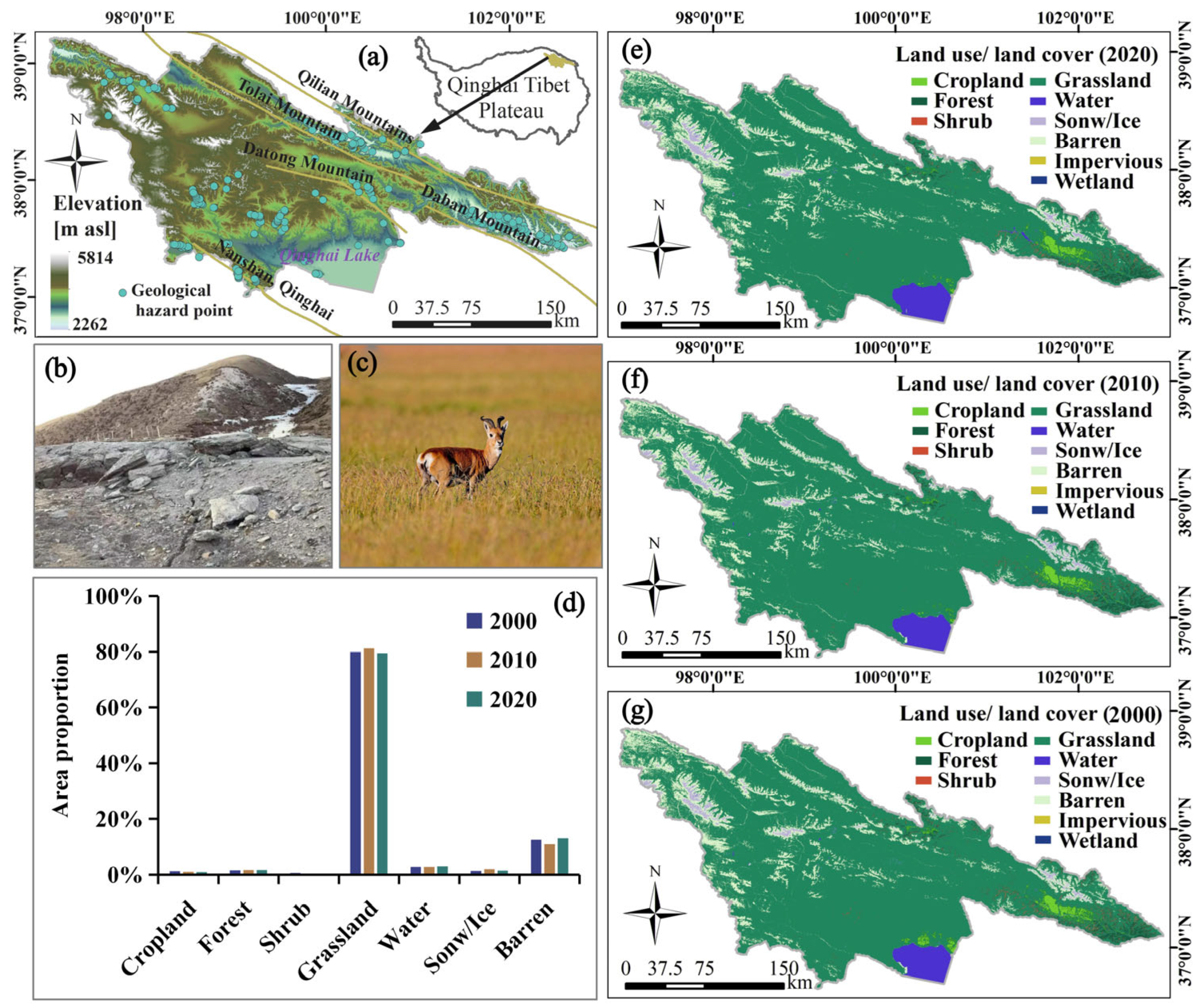
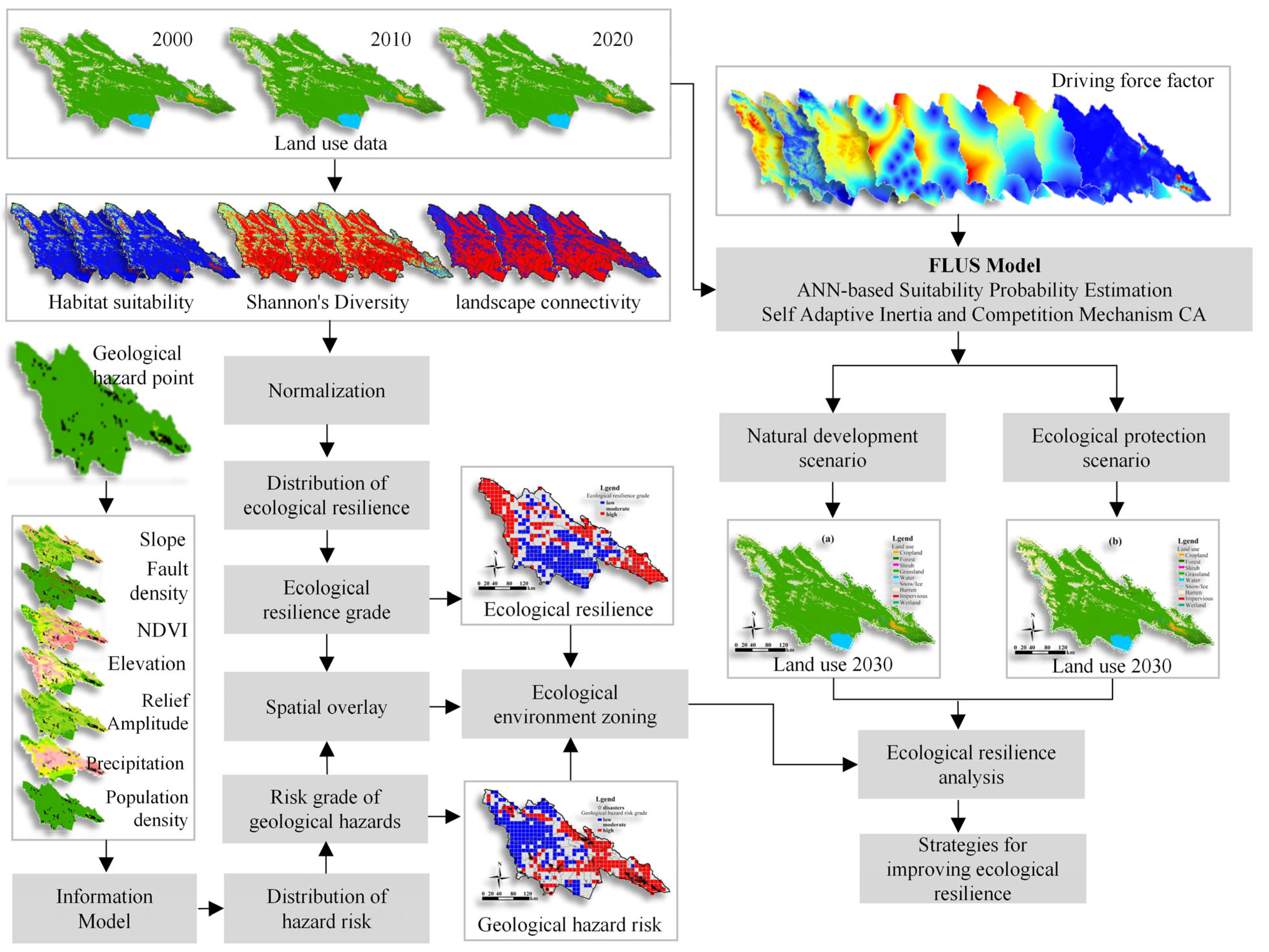
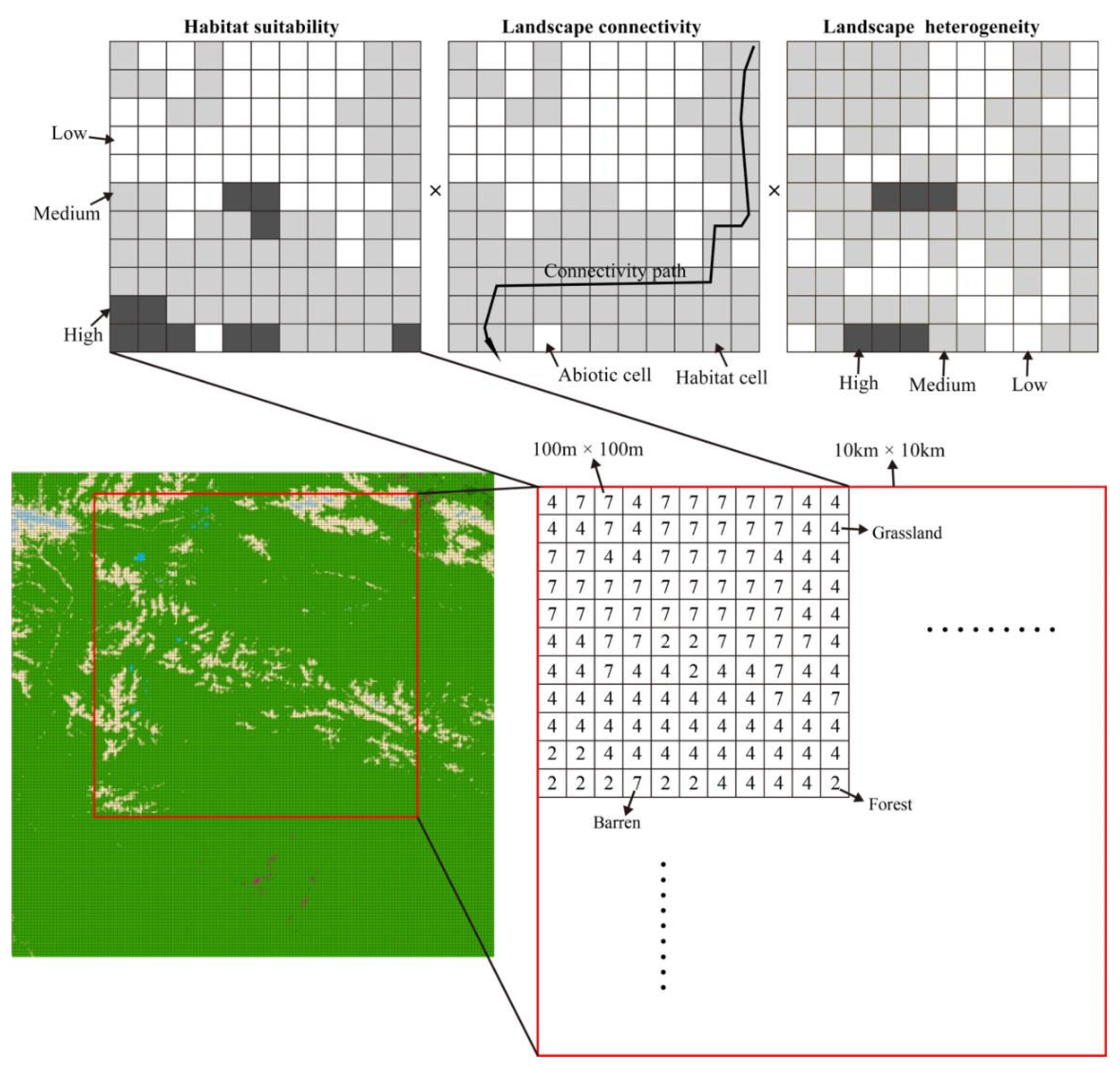
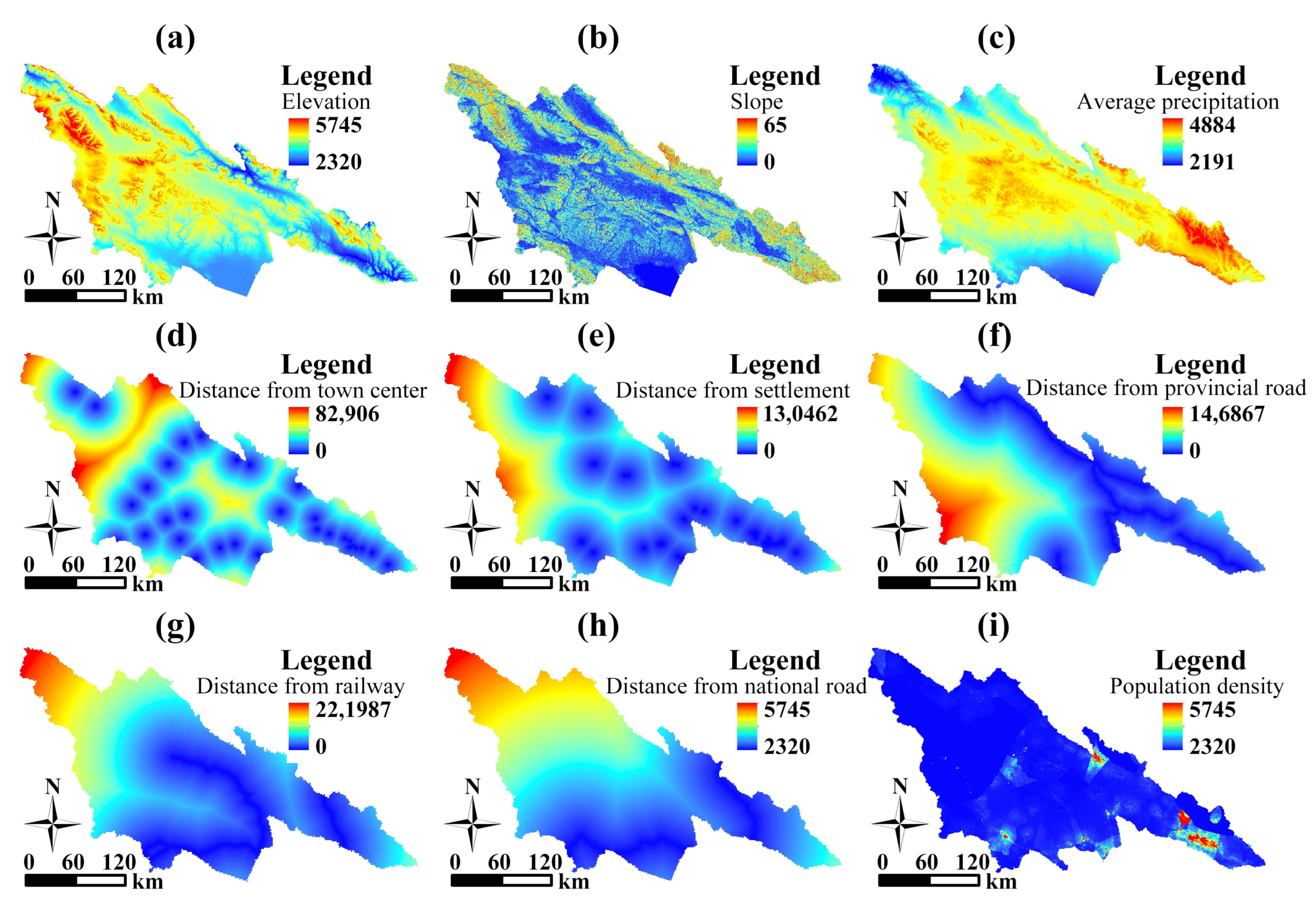
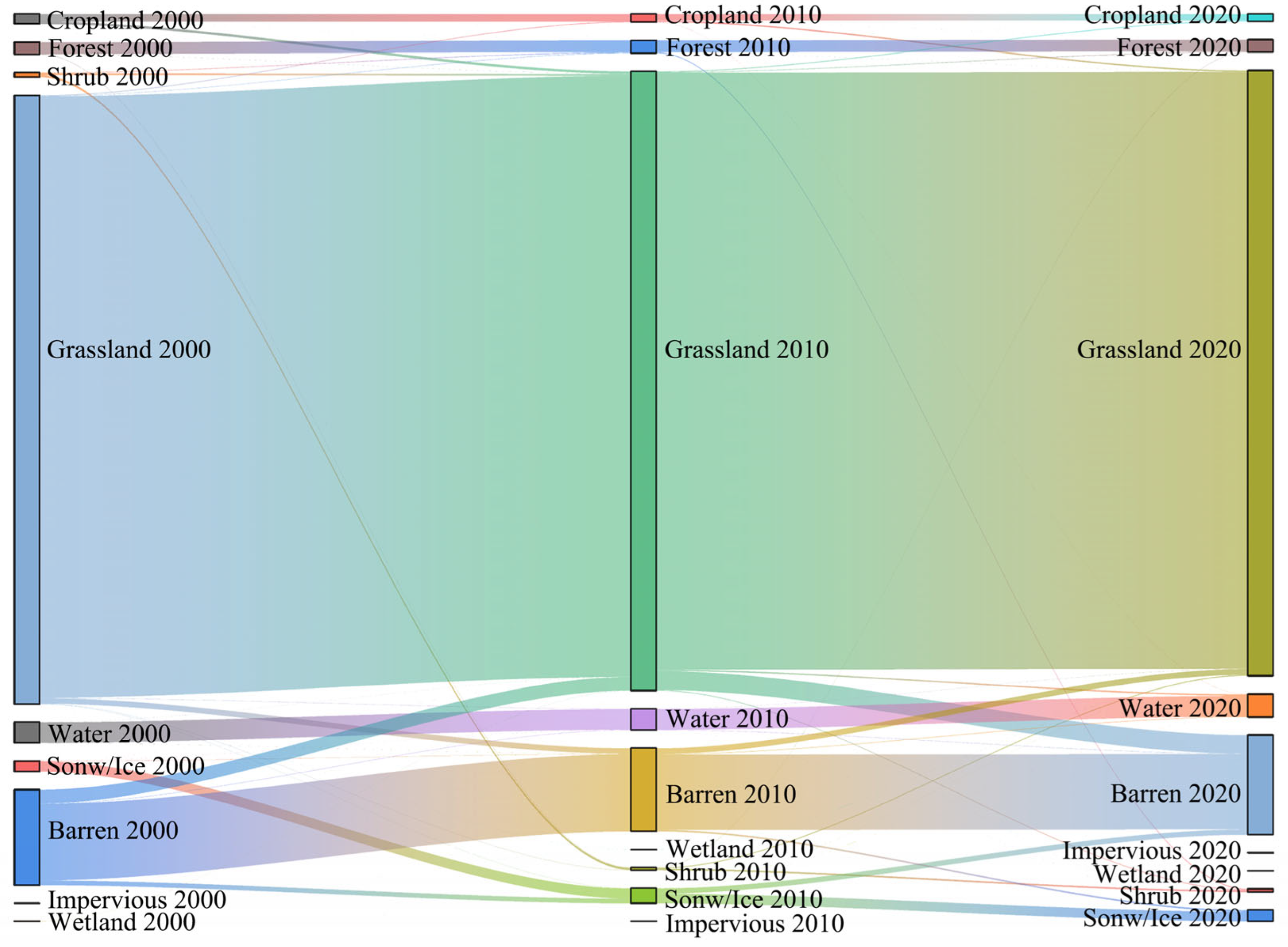
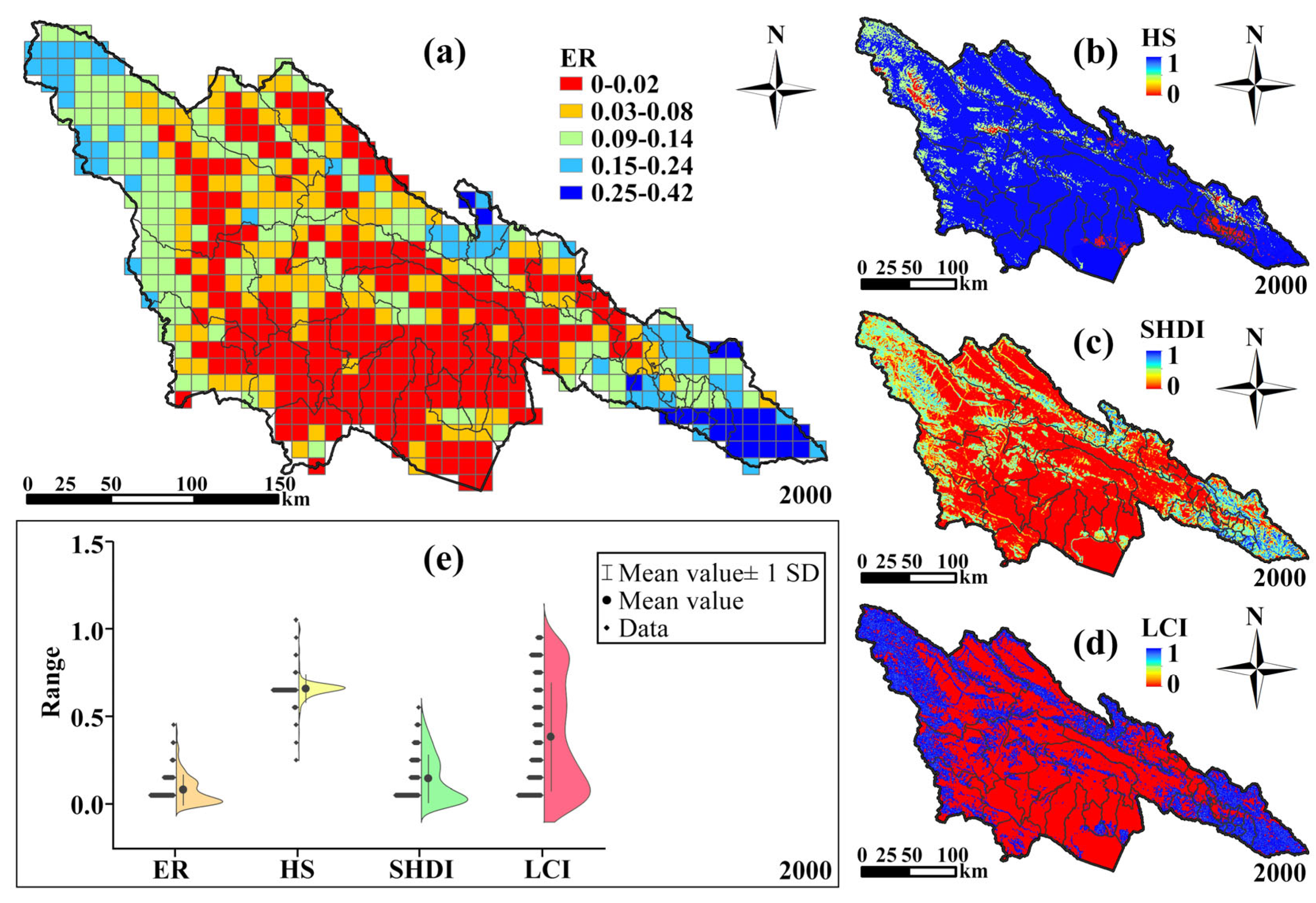
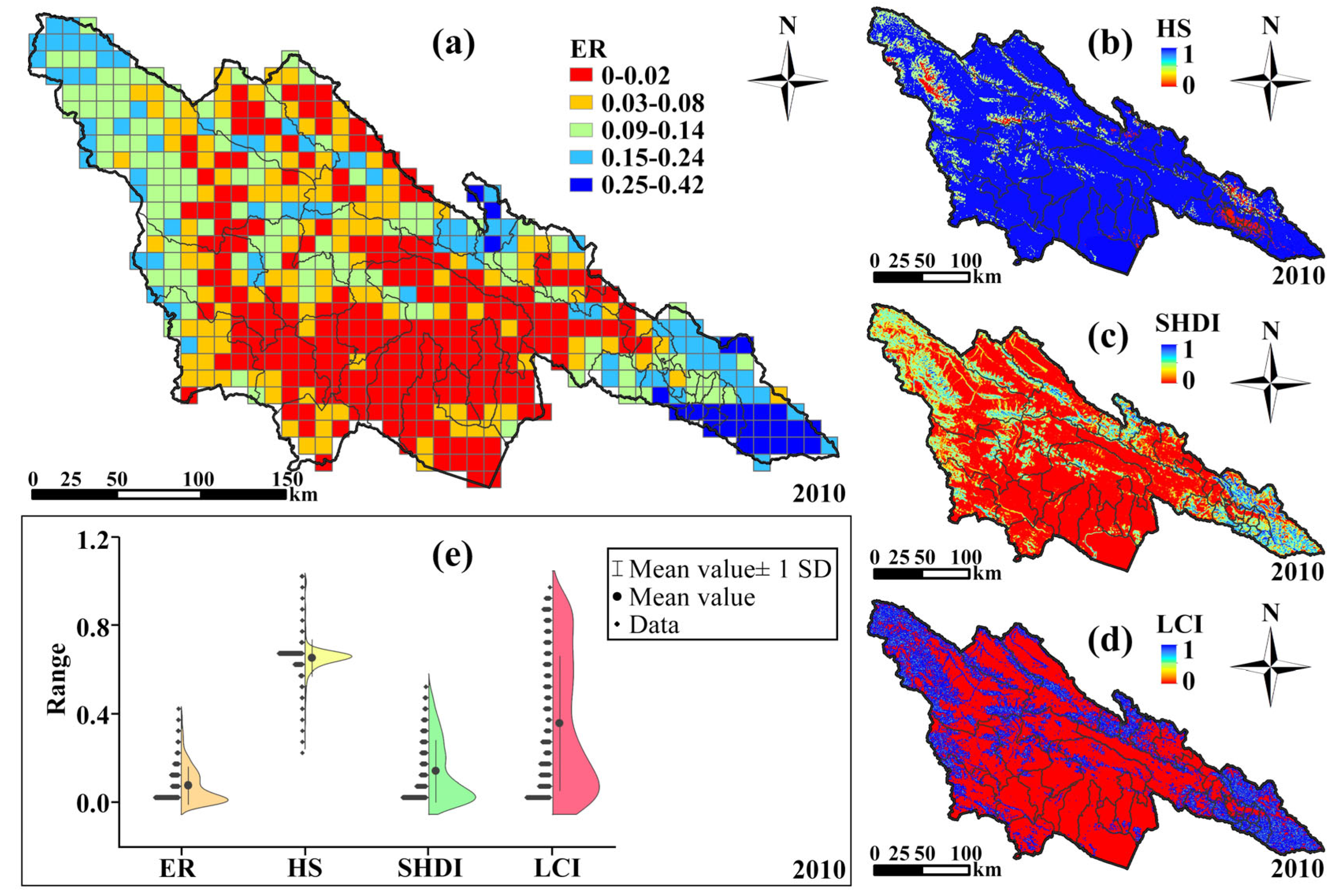
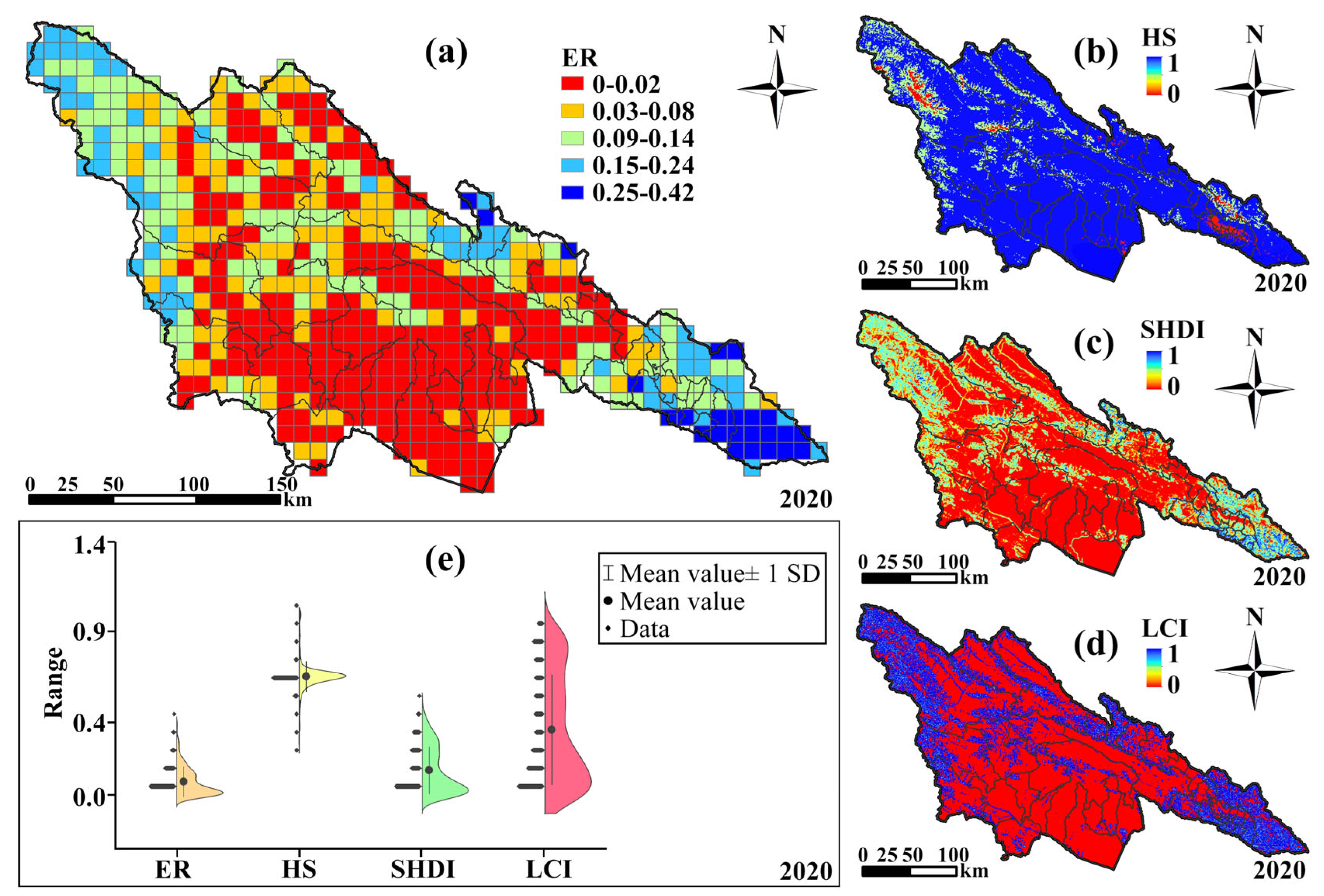
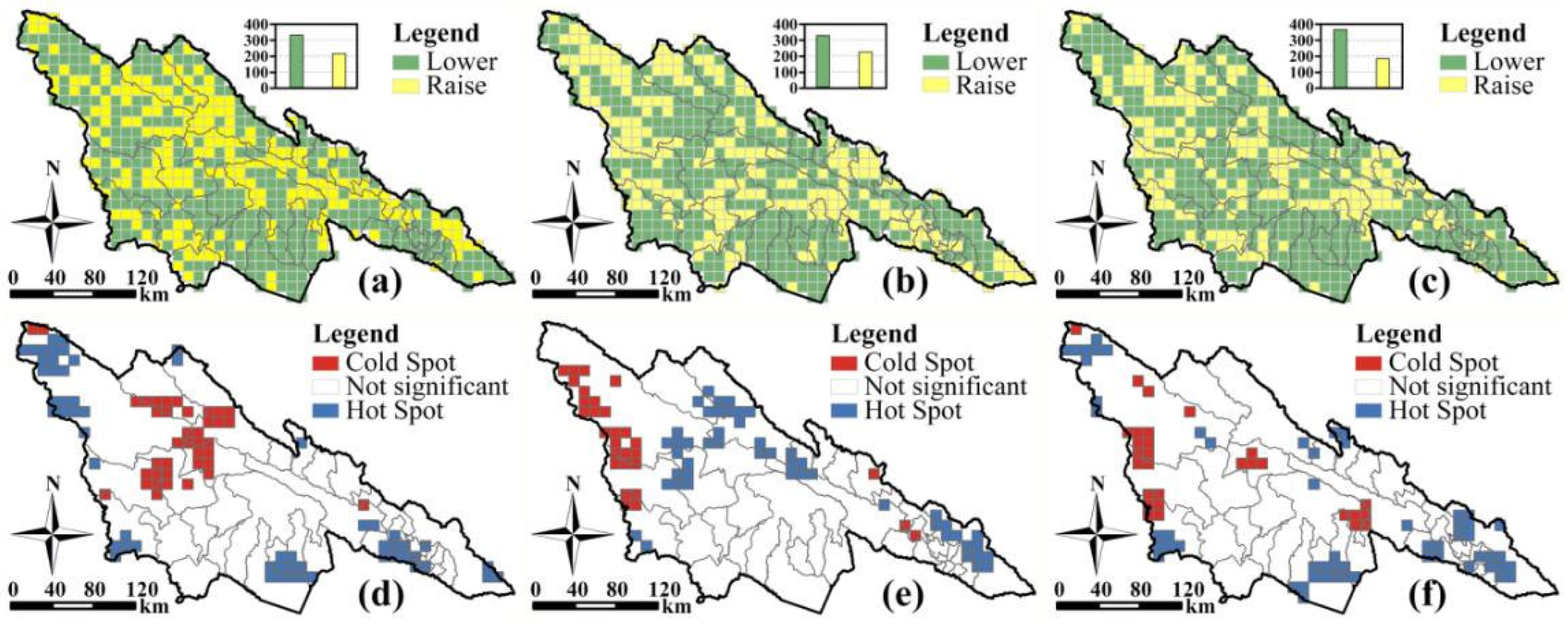

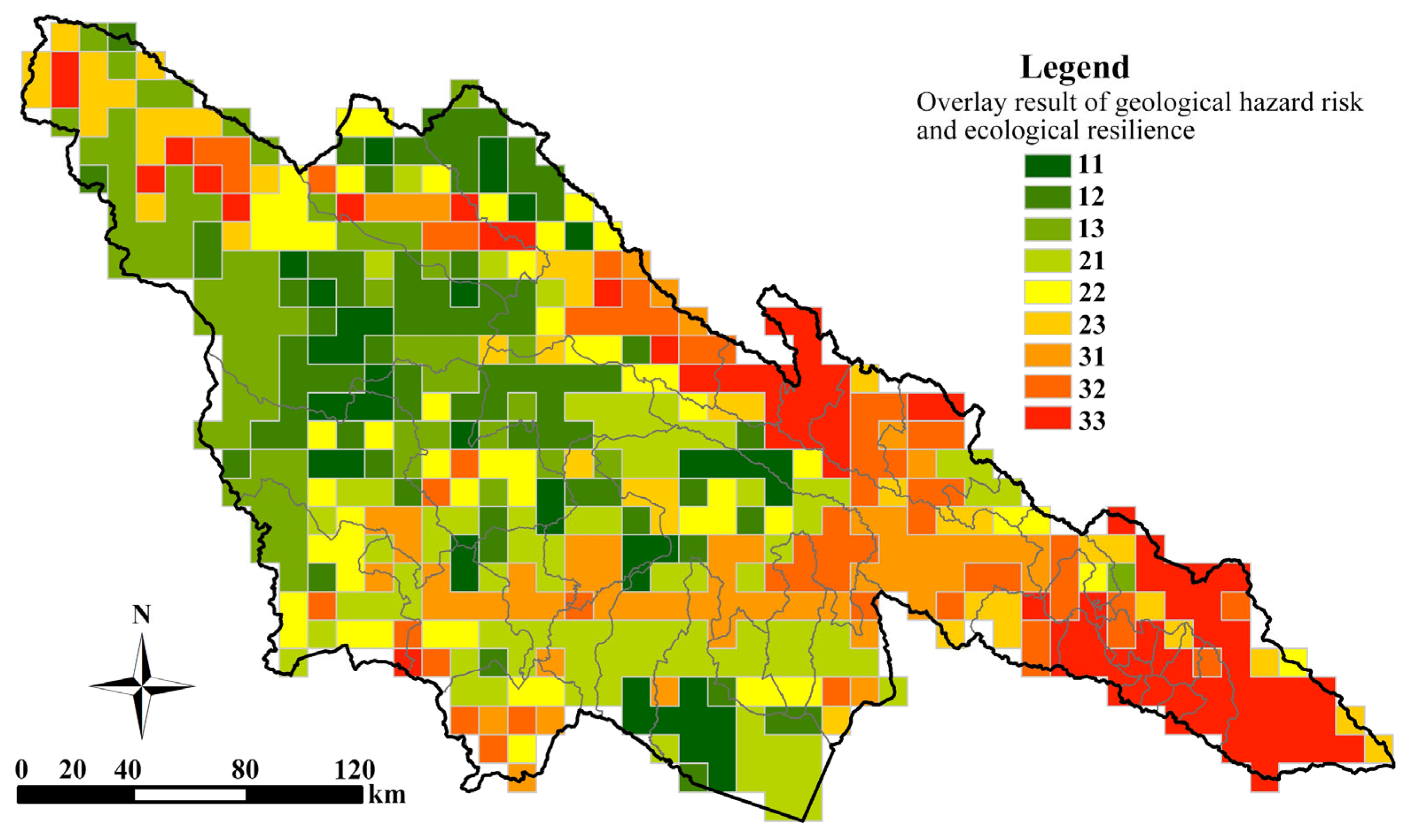
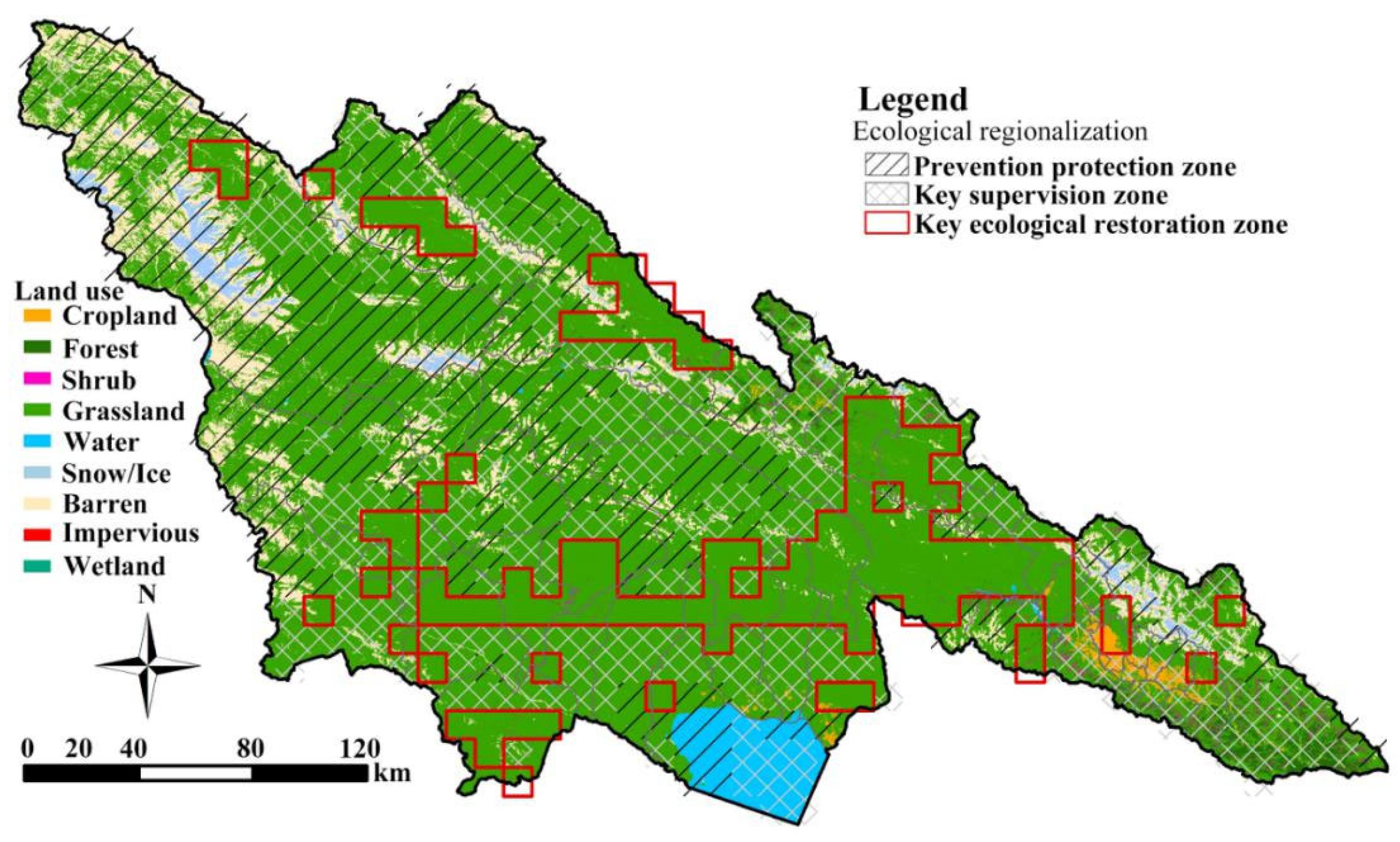
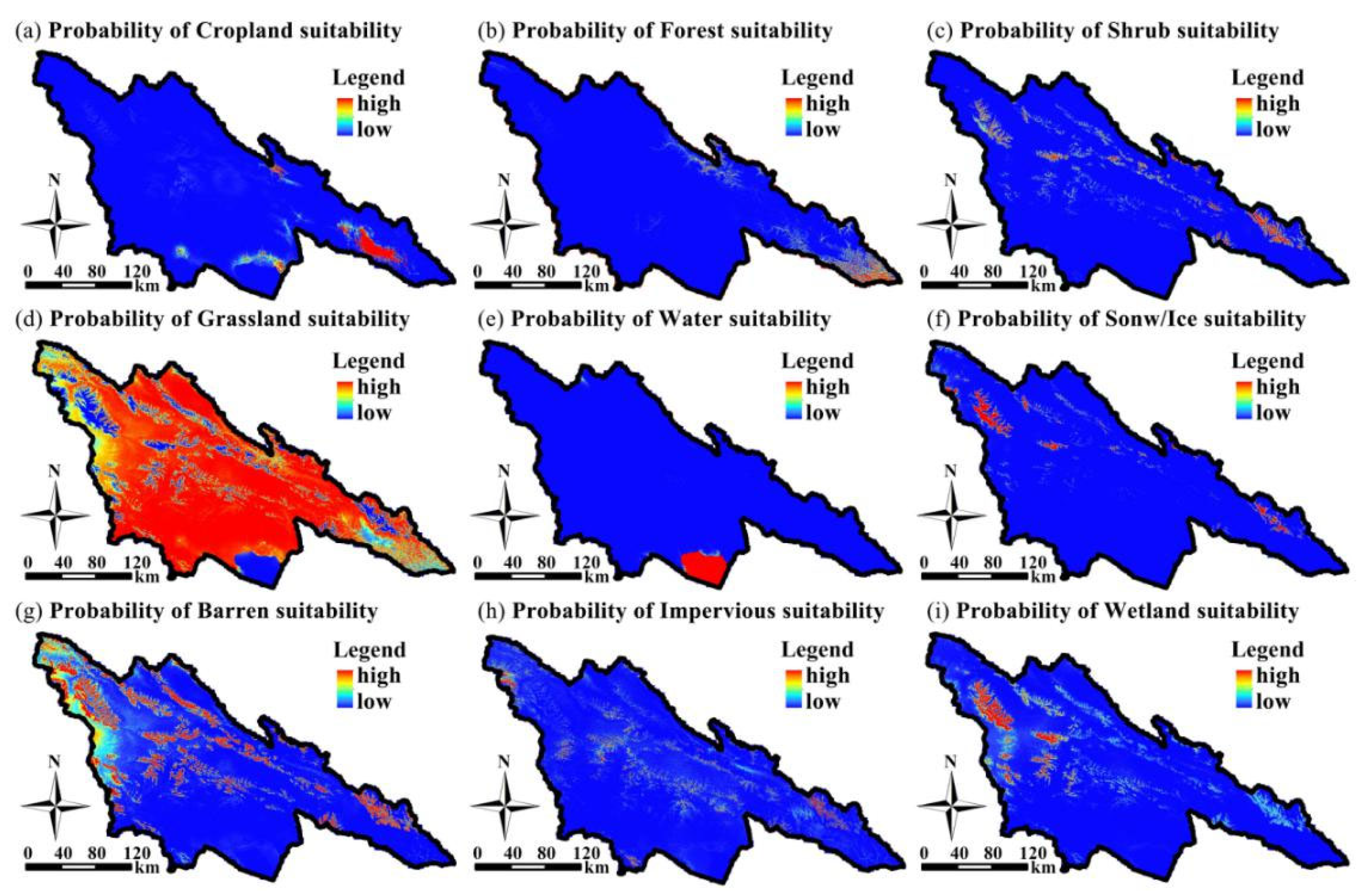

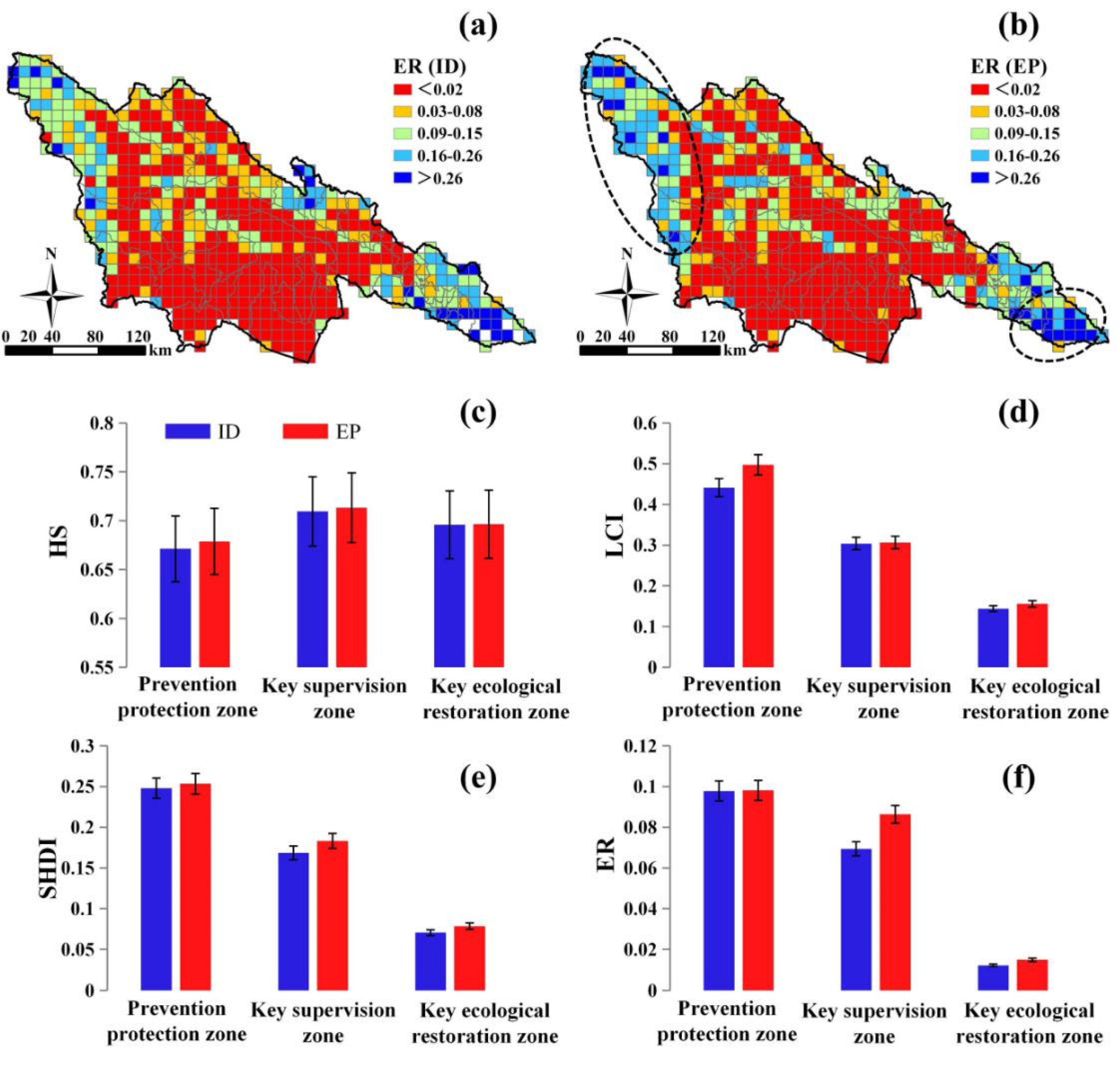
| Data Type | Data Format | Data Source/Processing | Spatial Resolution |
|---|---|---|---|
| Land use/land cover | Raster | Wuhan University 1990–2020 China 30 m Land Cover Dataset (http://doi.org/10.5281/zenodo.4417809, accessed on 1 February 2022) | 30 m |
| Digital elevation model (DEM) | Raster | Resource and Environmental Science and Data Center (https://www.resdc.cn, accessed on 1 February 2022) | 30 m |
| Geological disaster data (1960–2020) | Excel | 1:100,000 county-level geological disaster survey and the government report | - |
| Precipitation | Raster | Resource and Environmental Science and Data Center (https://www.resdc.cn, accessed on 1 February 2022) | 1 km |
| NDVI | Raster | Resource and Environmental Science and Data Center (https://www.resdc.cn, accessed on 1 February 2022) | 1 km |
| Population density | Raster | Resource and Environmental Science and Data Center (https://www.resdc.cn, accessed on 1 February 2022) | 1 km |
| Strike slip fault | Vector | National Earth System Science Data Center (http://www.geodata.cn, accessed on 1 February 2022) | - |
| Railway | Vector | Geospatial data cloud (http://www.gscloud.cn/, accessed on 1 February 2022) | - |
| Provincial road | Vector | Geospatial data cloud (http://www.gscloud.cn/, accessed on 1 February 2022) | - |
| National road | Vector | Geospatial data cloud (http://www.gscloud.cn/, accessed on 1 February 2022) | - |
| Settlement | Raster | Resource and Environmental Science and Data Center (https://www.resdc.cn, accessed on 1 February 2022) | 1 km |
| Administrative boundary | Vector | Geospatial data cloud (http://www.gscloud.cn/, accessed on 1 February 2022) | - |
| Town center | Vector | Geospatial data cloud (http://www.gscloud.cn/, accessed on 1 February 2022) | - |
| Cropland | Forest | Shrub | Grassland | Water | Snow/Ice | Barren | Impervious | Wetland |
|---|---|---|---|---|---|---|---|---|
| 0.5 | 1 | 1 | 0.7 | 1 | 0.1 | 0.6 | 0 | 1 |
| 2000/2020 (km2) | Cropland | Forest | Shrub | Grassland | Water | Snow/Ice | Barren | Impervious | Wetland |
|---|---|---|---|---|---|---|---|---|---|
| Cropland | 478.28 | 1.25 | 0 | 238.34 | 8.60 | 0.00 | 0.44 | 0.00 | 0.04 |
| Forest | 0.27 | 809.31 | 57.00 | 10.98 | 0.16 | 0.00 | 0.01 | 0.00 | 0.00 |
| Shrub | 0.00 | 44.34 | 141.29 | 148.71 | 0.19 | 0.00 | 0.01 | 0.00 | 0.00 |
| Grassland | 56.09 | 58.06 | 33.67 | 42,908.05 | 107.90 | 2.97 | 1191.91 | 0.00 | 0.57 |
| Water | 0.01 | 0.04 | 0.00 | 4.96 | 1497.02 | 1.82 | 11.57 | 0.00 | 0.01 |
| Snow/Ice | 0.00 | 0.00 | 0.00 | 0.42 | 4.64 | 639.37 | 123.50 | 0.00 | 0.00 |
| Barren | 0.59 | 0.02 | 0.00 | 806.07 | 49.19 | 189.24 | 5929.33 | 0.00 | 0.00 |
| Impervious | 0.00 | 0.00 | 0.00 | 0.00 | 0.01 | 0.00 | 0.00 | 0.05 | 0.00 |
| Wetland | 0.01 | 0.00 | 0.00 | 8.96 | 0.17 | 0.00 | 0.00 | 0.00 | 0.09 |
| Element | Mean | S.E. Mean | Median | SD | Min | Max | Statistics | p-Value | |
|---|---|---|---|---|---|---|---|---|---|
| HS | 2000 | 0.66 | 0 | 0.66 | 0.08 | 0.25 | 1.00 | 0.28 | 0 |
| 2010 | 0.66 | 0 | 0.66 | 0.08 | 0.23 | 1.00 | 0.29 | 0 | |
| 2020 | 0.66 | 0 | 0.66 | 0.08 | 0.22 | 1.00 | 0.30 | 0 | |
| SHDI | 2000 | 0.15 | 0 | 0.10 | 0.14 | 0 | 0.57 | 0.15 | 0 |
| 2010 | 0.14 | 0 | 0.09 | 0.14 | 0 | 0.53 | 0.15 | 0 | |
| 2020 | 0.14 | 0.01 | 0.09 | 0.13 | 0 | 0.53 | 0.15 | 0 | |
| LCI | 2000 | 0.38 | 0.01 | 0.31 | 0.31 | 0 | 0.95 | 0.12 | 0 |
| 2010 | 0.36 | 0.01 | 0.28 | 0.30 | 0 | 0.95 | 0.13 | 0 | |
| 2020 | 0.36 | 0.01 | 0.28 | 0.30 | 0 | 0.95 | 0.13 | 0 | |
| Category | Evaluation Factor | Grade | Ni | Ni/N | Si | Si/S | Information Value |
|---|---|---|---|---|---|---|---|
| Geological environment | Slope | <5 | 3 | 0.04 | 51 | 0.09 | −0.96 |
| 5–10 | 16 | 0.19 | 131 | 0.23 | −0.23 | ||
| 10–15 | 20 | 0.24 | 145 | 0.26 | −0.11 | ||
| 15–25 | 36 | 0.42 | 178 | 0.32 | 0.27 | ||
| >25 | 10 | 0.12 | 47 | 0.09 | 0.32 | ||
| Fault density | <0.04 | 34 | 0.40 | 221 | 0.40 | 0 | |
| 0.04–0.09 | 24 | 0.28 | 121 | 0.21 | 0.25 | ||
| 0.09–0.16 | 13 | 0.15 | 120 | 0.22 | −0.35 | ||
| 0.16–0.25 | 10 | 0.12 | 67 | 0.12 | −0.03 | ||
| 0.25–0.45 | 4 | 0.05 | 23 | 0.04 | 0.12 | ||
| NDVI | 0.02–0.31 | 4 | 0.05 | 73 | 0.13 | −1.03 | |
| 0.31–0.47 | 13 | 0.15 | 98 | 0.18 | −0.15 | ||
| 0.47–0.61 | 9 | 0.11 | 112 | 0.20 | −0.65 | ||
| 0.61–0.74 | 22 | 0.26 | 145 | 0.26 | −0.02 | ||
| 0.74–0.90 | 37 | 0.44 | 124 | 0.23 | 0.66 | ||
| Elevation | 2893–3385 | 29 | 0.34 | 71 | 0.13 | 0.98 | |
| 3385–3722 | 16 | 0.19 | 123 | 0.22 | −0.17 | ||
| 3722–3994 | 25 | 0.29 | 135 | 0.25 | 0.18 | ||
| 3994–4280 | 13 | 0.15 | 151 | 0.27 | −0.58 | ||
| 4280–5021 | 2 | 0.02 | 72 | 0.13 | −1.71 | ||
| Topographic undulation | <12 | 8 | 0.09 | 96 | 0.17 | −0.61 | |
| 12–21 | 19 | 0.22 | 146 | 0.26 | −0.17 | ||
| 21–30 | 28 | 0.33 | 148 | 0.27 | 0.21 | ||
| 30–42 | 18 | 0.21 | 103 | 0.19 | 0.13 | ||
| 42–64 | 12 | 0.14 | 59 | 0.11 | 0.28 | ||
| Climate | Precipitation | 2475–3126 | 5 | 0.06 | 50 | 0.09 | −0.43 |
| 3126–3511 | 15 | 0.18 | 99 | 0.18 | −0.02 | ||
| 3511–3779 | 29 | 0.34 | 127 | 0.23 | 0.39 | ||
| 3779–4029 | 24 | 0.28 | 211 | 0.38 | −0.30 | ||
| 4029–4554 | 12 | 0.14 | 65 | 0.12 | 0.18 | ||
| Human activities | ≥15° slope road density | <0.023 | 32 | 0.38 | 365 | 0.66 | −0.56 |
| 0.02–0.07 | 18 | 0.21 | 111 | 0.20 | 0.05 | ||
| 0.07–0.14 | 20 | 0.24 | 50 | 0.09 | 0.96 | ||
| 0.14–0.26 | 8 | 0.09 | 18 | 0.03 | 1.06 | ||
| 0.26–0.57 | 7 | 0.08 | 8 | 0.01 | 1.74 |
Disclaimer/Publisher’s Note: The statements, opinions and data contained in all publications are solely those of the individual author(s) and contributor(s) and not of MDPI and/or the editor(s). MDPI and/or the editor(s) disclaim responsibility for any injury to people or property resulting from any ideas, methods, instructions or products referred to in the content. |
© 2025 by the authors. Licensee MDPI, Basel, Switzerland. This article is an open access article distributed under the terms and conditions of the Creative Commons Attribution (CC BY) license (https://creativecommons.org/licenses/by/4.0/).
Share and Cite
Liu, F.; Huang, H.; Lei, F.; Liang, N.; Cao, L. Ecological Resilience Assessment and Scenario Simulation Considering Habitat Suitability, Landscape Connectivity, and Landscape Diversity. Sustainability 2025, 17, 5436. https://doi.org/10.3390/su17125436
Liu F, Huang H, Lei F, Liang N, Cao L. Ecological Resilience Assessment and Scenario Simulation Considering Habitat Suitability, Landscape Connectivity, and Landscape Diversity. Sustainability. 2025; 17(12):5436. https://doi.org/10.3390/su17125436
Chicago/Turabian StyleLiu, Fei, Hong Huang, Fangsen Lei, Ning Liang, and Longxi Cao. 2025. "Ecological Resilience Assessment and Scenario Simulation Considering Habitat Suitability, Landscape Connectivity, and Landscape Diversity" Sustainability 17, no. 12: 5436. https://doi.org/10.3390/su17125436
APA StyleLiu, F., Huang, H., Lei, F., Liang, N., & Cao, L. (2025). Ecological Resilience Assessment and Scenario Simulation Considering Habitat Suitability, Landscape Connectivity, and Landscape Diversity. Sustainability, 17(12), 5436. https://doi.org/10.3390/su17125436





